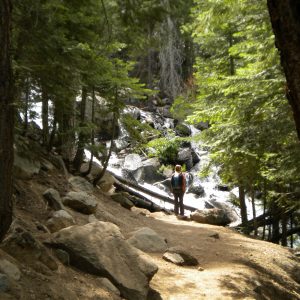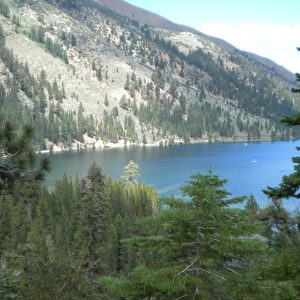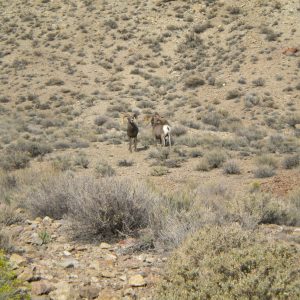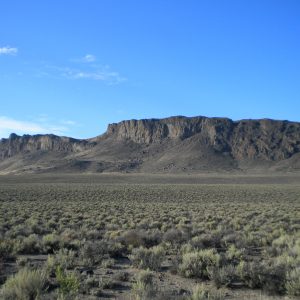
View of Yosemite Valley from Tunnel View
Before my internship at Yosemite National Park the furthest West I had been was Yellowstone National Park. So, on the drive out here in mid-August, everything was exciting and new – a preview of what was to come in my internship. When I first entered the park from the East entrance I was instantly in awe. I was driving on Tioga Road which travels from the East entrance of the park to the West. The ride took about 2 hours and was stunning from start to finish. I saw granite cliff faces, clear water, large forests, huge trees, waterfalls, and mountain peaks. I would later learn that this drive still amazes NPS workers that have lived in this area for 20+ years. I don’t think I could ever get jaded!
The very first week on the job, I was out in the backcountry with one of my mentors, a park botanist, and her team in the Virginia Lakes area. The project we were working on was unique lake flora monitoring. This included travelling to remote lakes and inventorying the aquatic plant species. Sometimes this included standing on the edge of the lake and looking at the plants below the high water mark, other times this included getting into freezing cold snow melt water to see what plants were in the middle of the lake.
As we traveled between lakes, we were constantly on the lookout for rare plants. When we found them we would set up a plot and record data about the habitat. This could take anywhere from 1-3 hours.

Collecting hydrology data from a small, mucky pond
On these trips we would spend a lot of time collecting plants that have few vouchers from certain areas of the park, identifying plants (I am getting better at expanding my botanical vocabulary), and inventorying aquatic and rare plant species.

Beginning our day at Boundary Lake
My botanist mentor and her team have found almost 100 new species for the park in the past couple of years. She has also described a new plant to science – Platanthera yosemitensis or Yosemite bog orchid. It is endemic to California’s Sierra Nevada range. More populations of this orchid are expected to be found up to 50 miles south of the known Yosemite sites. It is exciting to work with someone who is so devoted to the work!

Tofieldia occidentalis in a rare plant plot

Narthecium californicum in a rare plant plot

Drosera rotundifolia in a rare plant plot
At the beginning of September I was fortunate enough to partake in an 8 day pack trip to the northern boundary of the park. This is a part of the park that not many people get to see, but is one of my favorite places I have ever visited! Mules carried in our food and equipment (including our plant presses 🙂 ). The team on this trip included my mentor, two contracted botanists from California, and two phycologists from the New York Botanical Gardens. Each day we would try to inventory as many lakes as possible in an attempt to look at species population changes over large areas of the park. To answer questions like, why are these species here and not there, are there there species in the park that only occur with specific other species, and is there a line drawn between species presence or absence and why. On most of our trips we collect algae and send it back to the New York Botanical Gardens, but on this particular trip, the experts were with us. So each night the phycologists would spend hours with their microscopes to determine what species we found that day. It was a really interesting experience to assist both parties in their collecting, identifying, and mounting!

The cowboy with the horses and mules carrying our food and equipment
One particular day on the job I was able to canoe around Lake Eleanor and inventory the aquatic plant species. This lake is one of the most diverse in the park. We found almost 30 different aquatic species in or around the lake in two days! A lake in the park typically has 2-7 aquatic species, usually with a similar combination depending on the area.

Canoe day on Lake Eleanor
At the end of September I got the opportunity to travel around the park with a group of 10 lichenologists from all around the world! They were conducting the first lichenblitz for Yosemite. It was interesting to learn about all of the different areas of expertise within the lichen field. Some worked exclusively on lichen that grows on trees, others worked on rocks, some on certain geological formations. The chisel and hammer hitting the rocks became a very familiar sound when travelling with this group (and a good way to find people if they went missing). I learned that a lot of the time it is not easy to identify the species in the field, so the team collected samples to take back and identify in the lab.

Lichenologists taking samples from rocks on the side of Bridalveil Falls

One night, I was able to follow the wildlife management team around chasing bears out of campgrounds and populated areas. The shift started at 6PM and went until 3AM. The idea is to teach the bears that it is not OK for them to be in certain areas of the park, where there are a lot of people because it is potentially dangerous for the visitors and the bears. Therefore, most of the bears in the park are radio collared so they can be monitored using GPS. The “bear team” does rounds to check up on problem bears all night long. I have little experience with wildlife management, but this experience was an extreme introduction!

A couple of black bears near Crane Flat
Now that the field season is over, I have been working on mounting and labeling the specimens that we collected this past summer. Along with that, I have been working with the museum registrar (my other mentor) data-basing specimens, reorganizing, and editing the herbarium in hopes of getting it online within the next year or so. It is exciting to be a part of this project that will improve the quality of the resource accessibility.
It has been great to get to know people from many different divisions of the park. I have worked with the botany team, vegetation and restoration, wildlife management, museum curators, and interpretation. In addition, I have been able participate in trips that included botanists and hydrologists from USGS, and knowledgeable botanists contracted out through the park.
The many different experiences that I have had through this internship have taught me so much about different areas of conservation. The work that I have had the opportunity to partake in has been challenging, enjoyable, and rewarding. I’m excited to learn what my internship has in store for me in the following months. I have quickly learned why this place is clearly irresistible to many!

A field day in the northern park of the park
Stephanie Zinken, N.P.S., Yosemite National Park










































































